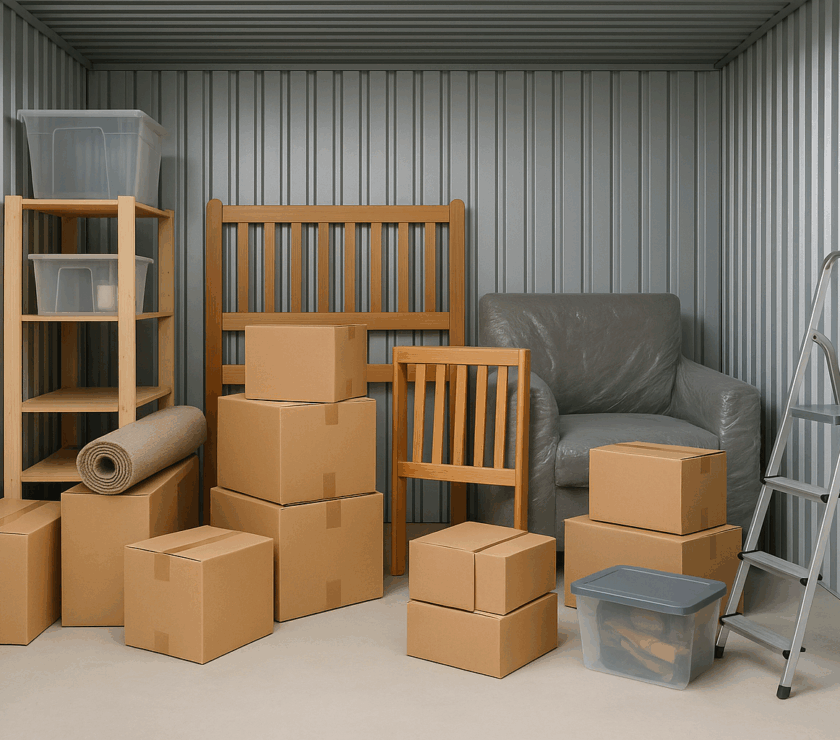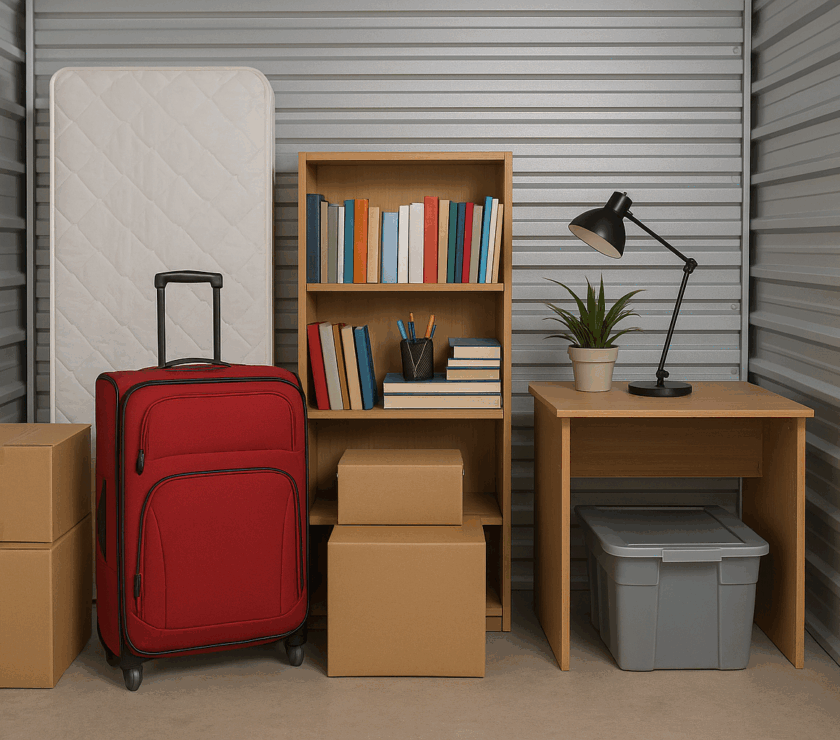Maintaining a home requires constant attention to potential problem areas, from leaks and drafts to structural issues and aging systems. Identifying and fixing these issues early can save you from costly repairs and help maintain a safe and comfortable living space. In this blog, we’ll explore how to find and fix the most common problem areas in your home, offering practical tips and solutions, including how self-storage can play a role in helping you manage household clutter.
1. Inspect the Roof and Gutters
Finding the Problem: The roof is one of the most critical components of your home, protecting it from the elements. Check for missing, curling, or damaged shingles and pay special attention to areas around chimneys, skylights, and vents where leaks are more likely to occur. Don’t forget to check your gutters for clogs, as blocked gutters can lead to water backup, which can damage your roof and foundation.
Fixing the Problem: Minor repairs such as replacing shingles or sealing small leaks can be done with basic DIY skills. However, for extensive damage, it’s best to contact a professional roofer. As for your gutters, clean them regularly to ensure that water flows properly away from your home’s foundation.
2. Check for Water Leaks
Finding the Problem: Water leaks can lead to severe damage and mold growth. Inspect areas under sinks, around appliances like dishwashers and washing machines, and in the bathroom for signs of water damage. Stains on ceilings or walls are also clear indicators of a leak.
Fixing the Problem: Minor leaks, such as those caused by loose fittings, can often be repaired by tightening connections or applying plumber’s tape. For more significant plumbing issues, it’s best to hire a professional to avoid causing further damage.
3. Seal Drafty Windows and Doors
Finding the Problem: Drafty windows and doors can waste energy by allowing heat to escape in the winter and cool air to escape in the summer. Test for drafts by holding a lit candle or piece of paper near the edges of your windows and doors. If the flame flickers or the paper moves, you’ve found a draft.
Fixing the Problem: Seal gaps around windows with caulking, and use weatherstripping on doors to prevent drafts. Door sweeps are also effective at blocking drafts that enter from underneath doors. For old or poorly insulated windows, consider upgrading to energy-efficient models.
4. Examine Your Foundation for Cracks
Finding the Problem: Your home’s foundation is vital to its structural integrity. Check for cracks in both the interior and exterior walls, particularly around the basement. Small cracks are normal, but larger cracks, especially those wider than a quarter of an inch, can indicate serious structural problems.
Fixing the Problem: Small cracks can be filled with a concrete patching compound. For more severe issues, like significant foundation settling, consult a foundation repair expert. Ignoring foundation problems can lead to major structural damage and costly repairs down the line.
5. Test Electrical Outlets and Circuit Breakers
Finding the Problem: Faulty electrical outlets or overloaded circuits can pose a fire hazard. Look for flickering lights, buzzing outlets, or frequently tripped circuit breakers. Use an outlet tester or multimeter to check whether your outlets are functioning properly.
Fixing the Problem: For minor issues, such as a faulty outlet, you can replace the outlet if you’re comfortable working with electricity. Always turn off the circuit breaker before doing any electrical work. For more complex electrical issues, it’s best to hire a licensed electrician to ensure safety and compliance with local building codes.
6. Inspect HVAC Systems
Finding the Problem: Your heating, ventilation, and air conditioning (HVAC) system keeps your home comfortable year-round. Look for signs of inefficiency, such as weak airflow, inconsistent temperatures, or unusual noises. Check your air filters and thermostat settings as part of your inspection.
Fixing the Problem: Change your HVAC system’s filters regularly, as clogged filters can reduce efficiency. Clean your vents and ensure they are not blocked by furniture. Schedule annual professional inspections and tune-ups to keep your HVAC system in top condition. If your system is old or frequently breaking down, it might be time to upgrade to a more energy-efficient model.
7. Address Mold and Mildew Issues
Finding the Problem: Mold thrives in damp environments, such as bathrooms, basements, and areas around windows. Visible mold or a musty smell is a clear sign of an issue. Mold can be harmful to your health and can spread quickly if left untreated.
Fixing the Problem: Clean small patches of mold with a mixture of water and bleach or a commercial mold remover. Ensure good ventilation in damp areas by using exhaust fans or dehumidifiers. For larger infestations, or if mold is growing behind walls or under flooring, it’s best to call a professional mold remediation service.
8. Assess Your Home’s Insulation
Finding the Problem: Poor insulation can cause significant energy loss, making it harder to keep your home warm in the winter and cool in the summer. Check your attic, walls, and floors for adequate insulation. Cold spots or drafts in certain areas may indicate insufficient insulation.
Fixing the Problem: Adding or upgrading insulation in your attic, walls, or floors can help make your home more energy-efficient. Consult an insulation expert to determine the best type of insulation for your home and climate.
9. Use Self-Storage to Declutter Your Home
Finding the Problem: One common problem many homeowners face is a lack of storage space. Over time, homes can become cluttered with seasonal items, rarely used belongings, or furniture that doesn’t fit. Clutter not only makes your home look disorganized but can also make cleaning and maintenance more difficult.
Fixing the Problem: A self-storage unit is an excellent solution for homeowners looking to free up space without getting rid of their belongings. Items like holiday decorations, seasonal clothing, or furniture that you don’t need regularly can be stored safely offsite. Self-storage gives you flexibility, allowing you to rotate items in and out of your home as needed without overcrowding your living spaces.
When looking for a self-storage facility, consider factors such as security, climate control, and accessibility. If you’re in Salisbury, for instance, you can check out Rhino Storage, a local option that offers a range of unit sizes to meet your storage needs.
10. Look for Pest Infestations
Finding the Problem: Pests like rodents, termites, or ants can cause significant damage to your home if left unchecked. Check for droppings, chewed wires, wood damage, or small holes in walls and floors. In some cases, you may even hear pests moving around in your walls or attic.
Fixing the Problem: Seal any cracks or gaps in your home’s exterior to prevent pests from entering. Set traps or use pest control products to address minor infestations. For larger infestations, or if you suspect termites, it’s best to hire a professional pest control service to ensure the problem is dealt with effectively.
Conclusion
Finding and fixing problem areas in your home is essential for maintaining a comfortable, safe, and efficient living space. Regular inspections of your roof, foundation, plumbing, electrical systems, and insulation can prevent small issues from turning into major repairs. Additionally, utilizing self-storage can help declutter your home, giving you more space to enjoy while keeping your belongings safe and accessible.
Whether you’re handling minor repairs yourself or calling in professionals for larger projects, addressing these common problem areas will save you time, money, and stress in the long run. If you’re running out of space and need a flexible solution, consider using self-storage to store items that you don’t need immediate access to, helping you create a more organized home.



